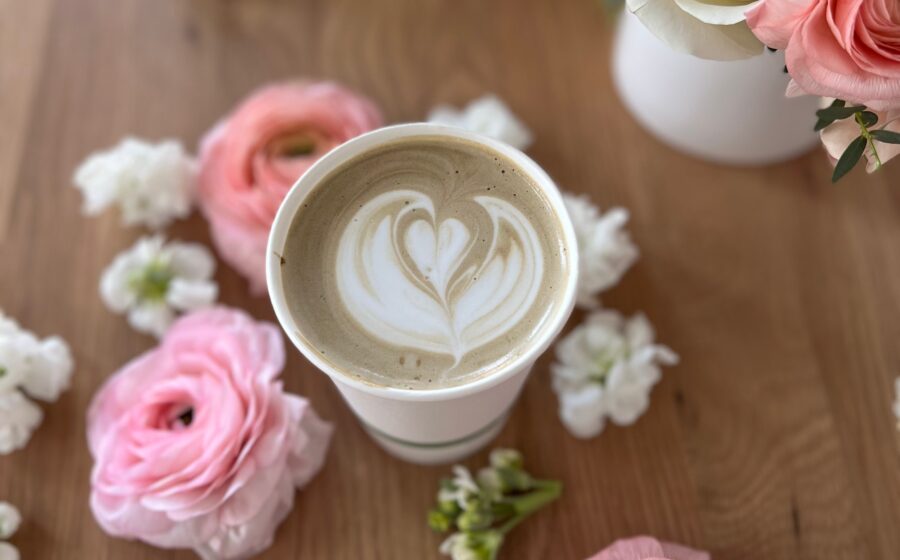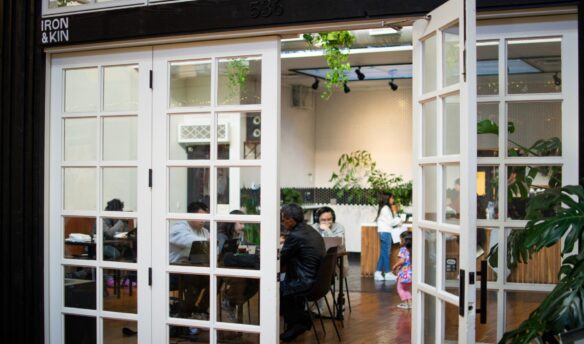Jessica Han had always been drawn to flowers and coffee. For years, she dabbled in floral arrangements as a side hobby in her hometown of San Jose, California, making bouquets for friends and family to celebrate special occasions. But it wasn’t until her talent caught the attention of strangers that she realized her passion could be something more.
Han dreamt of a space that merged her two interests. Many told her it was risky to open a retail venture—but she was determined to turn her vision into reality.
Starting small with pop-up shops and workshops, Han slowly built her reputation and customer base until she was ready to take the plunge. And so, Bloomsgiving was born—a unique concept that blends a flower and plant shop with a café.
Coffee, plant, and flower shops are coming together under one roof in hybrid spaces across the globe, where customers can sip on a latte as they browse floral arrangements and vining pothos plants. With an eye for aesthetics, shop owners are infusing the natural appeal of flowers and plants into their designs and menu choices. By doing so, they’re creating destination-worthy spots that redefine the traditional retail experience.
A New Leaf
Houseplants have been around for ages, but they’ve exploded in popularity over the last few years, especially among Millennials and Gen Z. From leafy monstera plants to mini succulents, everyone’s trying to bring a bit of the outdoors inside.
The pandemic undoubtedly fueled the growth of this trend. According to the Greenhouse Management 2020 State of the Industry report, 71% of North American greenhouses saw an increase in plant sales in 2020—and the National Gardening Association found that 18 to 34-year-olds are driving this boom in plant sales.

Despite the convenience of online plant retailers, most Americans still opt to buy their leafy friends from brick-and-mortar shops like home improvement centers and garden centers. Maybe it’s because consumers can get a closer look at the plant before making a decision, or perhaps it’s the satisfaction of bringing home a plant they’ve personally picked out.
Entering the market during the pandemic—and the peak plant craze—posed a challenge for Bloomsgiving. After signing the lease in the fall of 2019, Han spent over a year on the buildout before the store opened in December 2021. She admits that opening during the pandemic was daunting. “Luckily, people were starting to go out again when we were ready to open, but it was risky and scary for me to open up during that time,” she says.
Han knew that she needed to learn the ins and outs of the coffee industry to launch Bloomsgiving. Despite her experience with plants, she had never worked in the coffee world. So she went straight to the source, learning about coffee from a local roaster who eventually provided beans to their space, Academic Coffee.
But launching a hybrid coffee and plant store means you’re in the business of selling—and knowing about—two entirely different industries. Does your team need to know about both to thrive?
Striking the Perfect Balance
For Bloomsgiving, Han found a team of experienced baristas passionate about both coffee and plants. “Houseplants got big during the pandemic, so I was lucky enough to hire people that already had a huge interest in houseplants and a coffee background,” explains Han.
Maypop Coffee & Garden Shop, located in the St. Louis suburb of Webster Groves, Missouri, takes a different approach. Here, the coffee and garden sections are kept separate from each other. Grant Eschman, who manages the café, shares that co-founder and general manager Laura Tetley managed both sections initially. However, they realized it was too much for one person to handle.
Eschman has since taken over the cafe operations, leaving Tetley to focus solely on the greenhouse. It’s a system that works well, and Eschman is grateful to be able to lighten Tetley’s workload. “I saw what she was doing before, and it was a lot,” he says.
“I had five years of experience in specialty coffee before this,” Eschman adds. “And I also have my own garden experience. So when I saw this position, I thought it was perfect because I can put those skills together.”
Another factor that hybrid shops must consider is foot traffic. Do they experience different rushes than a standard café or garden shop?
According to Han, it depends on the day of the week. “We’ll get a rush after lunch, and it will be purely coffee sales,” she says. “But on the weekends, it’s mixed with a lot of plant and coffee sales.” However, floral sales remain a consistent source of revenue for Bloomsgiving, regardless of the time of day or week. “People are constantly buying flowers to send to people for their birthday gifts and anniversaries,” Han adds.
Beyond offering customers fresh-cut flowers and potted plants, many hybrid cafés are also finding creative ways to incorporate florals into their coffee menu.
Garden to Cup
In a hybrid shop that includes plants and coffee, it’s not uncommon to see the florals influence the café menu. Bloomsgiving has created unique drinks like an espresso tonic that incorporates rose and orange with tonic water. They also offer classic drinks with floral touches, such as lavender-infused lattes and drinks topped with dried rose petals. Han notes that customers particularly enjoy adding a small flower sprig to their drink or tucking it into the sleeve.
At Maypop, incorporating seasonal plants into the café menu is a top priority. “In January, we had a lot of rosemary because it was following Christmas. We made a rosemary and molasses latte that was really popular,” says Eschman.
The most popular item on Maypop’s menu is the honey lavender latte, which Eschman describes as “pollinator-friendly,” or using ingredients that support pollinators, such as bees, by promoting conscious beekeeping practices or providing habitats for their well-being. It reflects Maypop’s commitment to sustainability while infusing its menu with the beauty and freshness of the garden.
As Eschman explains, they recently launched a new lemon and mint cold foam to welcome the arrival of summer. This new addition is perfect for the busy season as it’s quick and easy to prepare and can be added to various drinks to elevate the flavor profile.
Eschman recalls an exciting project from last year when they created a spicy mocha recipe for October. “The chilies that I used were grown here on the premises, which was fun for me,” he says. Eschman is always looking for ways to incorporate fresh, seasonal ingredients into the menu at Maypop.
Currently, he’s focused on planning for the summer and finding creative ways to use up the abundance of basil leaves they have. Yet cafés and flower hybrid shops are more than places to grab a coffee, food, or a bouquet—they’re also creating a new kind of community hub.
Coffee, Plants, and Community
Han speaks enthusiastically about the community that they have created at Bloomsgiving. “People will stick around and chat,” she says. While some customers come in for a quick coffee, others spend more time asking questions about the plants and sharing updates on the ones they have bought. “We love that we’re building a community of people,” she adds. The sense of connection at Bloomsgiving is even more profound because the shop is situated right in the neighborhood where Han and her family reside.
Eschman explains that Maypop is designed to encourage customers to explore the space, “A lot of customers grab a to-go coffee and take their time perusing plants,” he says. “We also have a couple of seating spots in our greenhouse itself, which is always popular.”
Customers have told Han they appreciate the relaxing atmosphere of the shop and the combined smells of flowers and coffee. “They say it feels so different from other coffee shops, where everything seems more rushed.” In an industry that relies so much on volume, the act of grabbing a coffee to refuel can often feel hurried. Customers are rarely encouraged to pause and take in their surroundings. At hybrid coffee and plant stores, customers are invited to—literally—stop and smell the flowers.


















